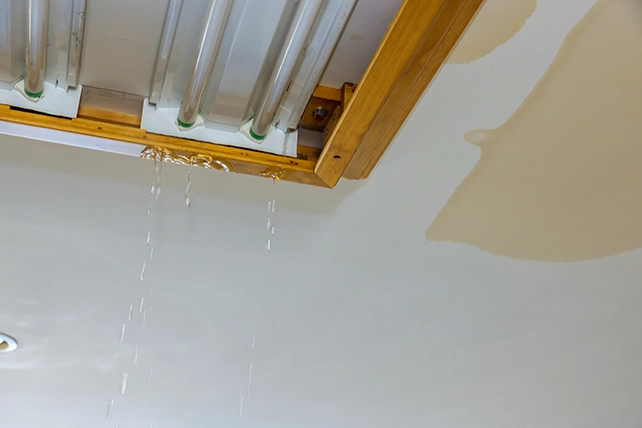How to Detect Early Warning Signs of a Roof Leak
Anyone with a commercial facility knows how expensive it is to maintain which is why it’s important to be proactive and prevent expensive problems before they start. Identifying early signs of a roof leak before they become a roofing emergency is essential for successfully maintaining your facility.

According to Risk & Insurance, a publication that covers risk management and commercial insurance, water damage is a leading cause of commercial real estate claims. In fact, water damage is one of the costliest and most common causes of property loss. According to industry International Organization of Standardization (ISO) data from 2021, annual incurred loss amounts in the United States related to weather and non-weather water damage totaled $500 million!
No matter what type of commercial building roof type you have, your facility can take the initiative and identify the most common examples of damage from a commercial roof leak that include:
Equipment Damage
Industrial facilities often house expensive and sensitive machinery and equipment. Water leaks can lead to rust, corrosion, short-circuiting, and other malfunctions resulting in costly repairs or the need for replacements.
Product Damage
If your facility stores raw materials, finished products, or inventory, leaks can damage these goods resulting in financial losses and potential supply chain disruptions.
Safety Hazards
Leaks can create slippery surfaces, increasing the risk of slips, trips, and falls. Additionally, water near electrical systems poses a significant safety risk because it can potentially lead to electrical shocks or fires.
Increased Energy Costs
Water infiltration can damage insulation, reduce its effectiveness, and lead to increased heating and cooling costs because poor insulation causes facilities to struggle to maintain temperature control.
Operational Downtime
Addressing the damage caused by leaks often requires halting operations, resulting in downtime and lost productivity.
Compromised Indoor Air Quality (IAQ)
Mold and mildew growth as the result of a roof leak can lead to poor IAQ and this can affect the health and well-being of employees and potentially result in increased incidences of illness and absenteeism.
Legal and Regulatory Issues
Persistent leaks and the resulting damage could violate building codes and safety regulations, leading to fines and legal liabilities.
To prevent these costly problems before they start, it’s critical to have a routine commercial roof maintenance plan in place to address roof leaks. If your facility doesn’t conduct regular commercial roof inspections, you should create such a plan immediately.
Aside from obvious roof leak signs, like dripping water or puddles inside your facility, there are several early warning indicators that can be identified that will alert you to a problem. These early warning signs include:
Water Stains or Discoloration
Carefully look for water stains or discoloration on ceilings, walls, or floors as they are often the first visible signs of a leak. Continuous exposure to water can weaken your facility’s structural components such as beams, columns, and the roof deck, which can eventually lead to sagging, cracking, or even collapse if not addressed promptly.
Bubbling or Peeling Paint
Moisture or water trapped underneath paint can cause it to bubble or peel away from the surface. If you notice this on the ceiling or the walls, have the areas inspected. When these spots are soft to the touch or if your finger can poke through, this is evidence you have a problem.
Sagging or Deformed Ceiling Tiles
Ceiling tiles that are sagging or deformed indicates they may have absorbed water. As such, take down the tiles and inspect them for water damage.
Increased Humidity Levels
Unusually high humidity levels inside a facility can also be a sign of a leak, especially when there are no other explanations. You can use a hygrometer to measure your building’s humidity level.
Mold or Mildew Growth
Mold or mildew appearing on ceilings, walls, or insulation can suggest ongoing water intrusion and require immediate attention.
Musty Odors
A musty or moldy smell can also indicate moisture buildup, which might be due to a leak. If you detect an odd odor, inspect the area for the roof leak warning signs already noted.
In addition to inspecting the inside of your facility, you should also regularly look at the exterior to see if you have any damage outside. Early warning signs of an exterior roof leak include:
Cracks or Gaps in the Roofing Material
Inspect the roof for visible cracks, gaps, or damaged flashing, which can allow water to enter the building.
Debris in Gutters or Drains
Clogged gutters or drains can cause water to back up and seep under roofing materials creating numerous problems.
Rust or Corrosion
Check metal components such as beams or HVAC equipment for rust or corrosion, which can indicate prolonged exposure to moisture. This may indicate there is a roof leak nearby.
If you’re still not sure where to start examining or protecting your facility or would prefer to hire an expert to inspect your facility, contact Capital Roof Care. Our trained roofing professionals can create an interior and exterior roof care service plan that will meet all your needs and save you money in the long run. All three service level options include:
- Comprehensive roof assessments
- Priority customer service
- 24/7 access to your roof maintenance information
By having a commercial roof maintenance program, you’ll enjoy the benefits of knowing your roof care is in the most capable and dependable hands all year long. Capital Roof Care also ensures your company knows what needs to be done to stay compliant with manufacturers’ requirements so they will honor repairs covered under their warranty agreements.
Sources: